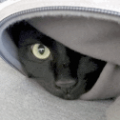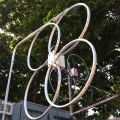G8JNJ
About
- Username
- G8JNJ
- Joined
- Visits
- 4,662
- Last Active
- Roles
- Member
- Points
- 130
Reactions
-
Adding Kiwi to my website
Hi All,
Details of my 'Loop on the ground' (or technically just above it) can be found on this webpage.
https://www.g8jnj.net/loop-on-the-ground
Treat the page as a preview as it's more of a working notebook and not really fit for publication yet.
It may also contain some errors and content that will eventually be removed if I decide it's not really worthy of inclusion.
I hope it may encourage other KiWi owners to experiment, as I've found it to be about 10dB more sensitive than typical 1m diameter loops. Although it's still about 5dB below the sensitivity required to hear galactic noise throughout the 20-30MHz frequency range.
The S/N stats on http://rx.linkfanel.net/ (although not very accurate) currently show my KiWi and LOG to have a value of just under 32dB, which is probably amongst the best of all KiWi's worldwide.
For comparison purposes most Kiwi's using 1m loops shown on the site typically manage around 20dB and most E-Probes achieve about 15dB.
You can take a listen to my KiWi using a 10ft per side loop and pre-amplifier on this url http://southwest.ddns.net:8073
Regards,
Martin - G8JNJ -
DRM Heard
-
DRM Heard
-
Problem with audio - Chrome [fixed, Windows 10 settings issue]
The issue was not associated with just the KiWi or cookies and I subsequently found that it affected other websites with audio enabled too.
After a lot of messing around I discovered that the problem was associated with the settings in Windows 10 App volume and device preferences.
Google had somehow got a different soundcard defined as the default, but for some reason the first browser session to be opened used the default device and any subsequent sessions opened the device defined for that application.
Reverting all back to the default fixed the problem (until the next time).
There are many different ways of defining the soundcard to be used in Win 10 and associated applications, so I'm not surprised they occasionally get out of sync with each other.
I'm not sure what caused it on this occasion, although it could have been associated with connecting a USB headset I occasionally use for Skype.
Regards,
Martin - G8JNJ -
Problem with audio - Chrome [fixed, Windows 10 settings issue]
The issue was not associated with just the KiWi or cookies and I subsequently found that it affected other websites with audio enabled too.
After a lot of messing around I discovered that the problem was associated with the settings in Windows 10 App volume and device preferences.
Google had somehow got a different soundcard defined as the default, but for some reason the first browser session to be opened used the default device and any subsequent sessions opened the device defined for that application.
Reverting all back to the default fixed the problem (until the next time).
There are many different ways of defining the soundcard to be used in Win 10 and associated applications, so I'm not surprised they occasionally get out of sync with each other.
I'm not sure what caused it on this occasion, although it could have been associated with connecting a USB headset I occasionally use for Skype.
Regards,
Martin - G8JNJ




